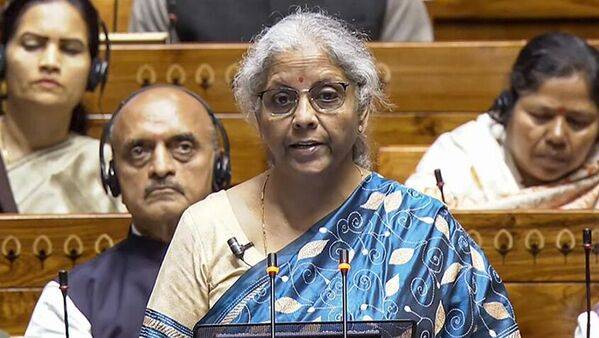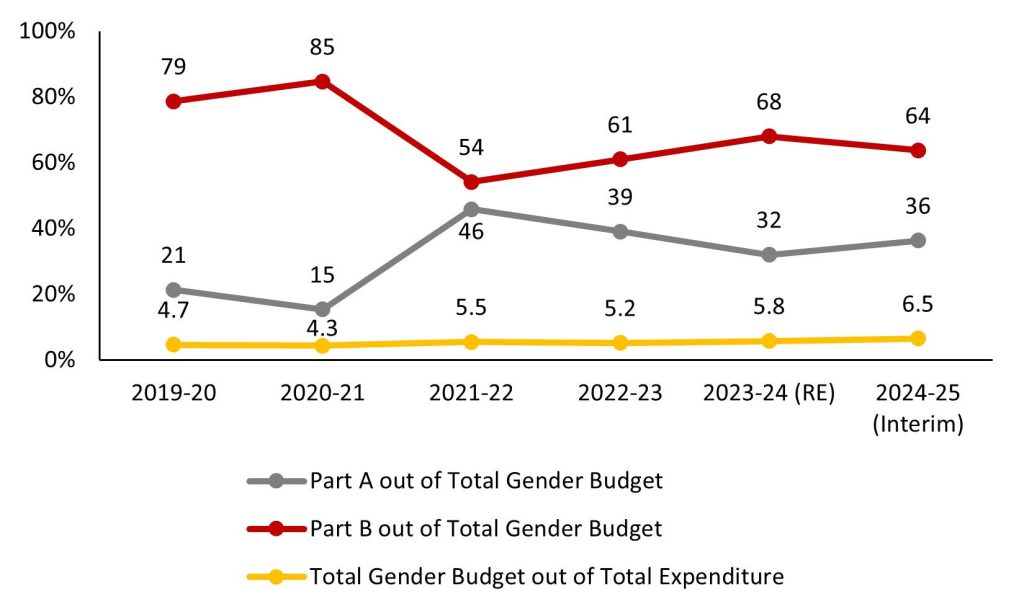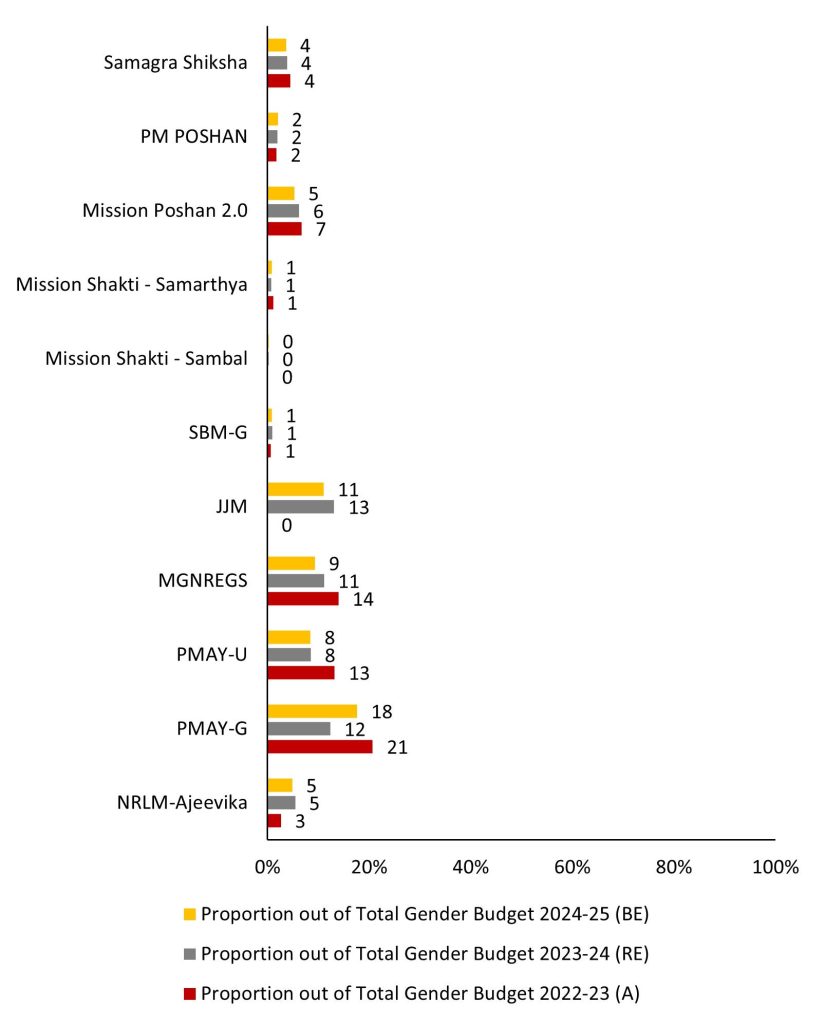Why This Year’s Interim Gender Budget Is Riddled with Ambiguity
The lack of clarity on exclusion of schemes in previous years, arbitrary increases in scheme allocations, and mismatch in scheme performance and corresponding allocations are concerns

From a key legislation on women’s reservation to “women-led development” at international platforms, nari shakti or woman power is at the core of the current government’s political vision. But does this vision also translate into a financial commitment through allocations in the government budget?
In her interim budget speech for Financial Year (FY) 2024-25, finance minister Nirmala Sitharaman reiterated her government’s focus on “mahilayen” (women), along with “garib” (poor), “yuva” (youth), and “annadata” (farmers). Prima facie, the gender budget or Gender Budget Statement (GBS) – a document that is released along with the Union Budget since 2005 – on the government’s gender-specific interventions through schemes and programmes – has increased to 6.5% of total expenditure in the interim budget 2024-25 from 5% in FY 2023-24.
The GBS has two parts – Part A with 100% scheme allocations for women and girls and Part B with 30-99% scheme allocations for them. So, schemes reported in Part A of the GBS are wholly meant for women and girls, while those in Part B have some aligned component(s) linked to them. It must be remembered that the GBS is not a separate budget for women and girls but a mere accounting (or “reporting”) exercise for existing schemes and programmes meant for them.
Not Much Has Changed
Year after year, the gender budget’s reporting exercise has been riddled with challenges. These challenges include ambiguous allocations as a consequence of mismatch between scheme intentions and corresponding financial prioritisation, lack of monitoring on spending, lack of disaggregated gender data, lack of clarity on inclusion of certain schemes or its subcomponents in Parts A or B, and misclassification of schemes. The interim gender budget, similarly, reflects some of these concerns.
Before diving into some of these challenges, let us first look at the trend in prioritisation through the GBS over the last few years (Figure 1). Allocation and expenditure (Actuals, or fund utilisation) on schemes with some components for women and girls (Part B) has always been higher than schemes wholly meant for them (Part A). In FY 2021-22, however, the gap in expenditure on Part A (46% of total gender budget) and Part B (54% of total gender budget) schemes was somewhat bridged. This gap in prioritisation between the two parts had widened again in the consequent years.
Does this suggest gaps in the design and implementation of wholly women-specific schemes? Maybe so. At the same time, the push should be towards gender responsiveness across social sector schemes. But, as long as the GBS acts as a reporting tool and not a monitoring tool, it would sustain the arbitrariness of this exercise.

In FY 2024-25, the Budget Estimates (BE, or planned expenditure) through schemes in the gender budget has seen an uptick of approximately 39% from previous FY. However, this increase is over 19% when compared to the Revised Estimates (RE, or reviewed expenditure till mid-of-year) of FY 2023-24. So, while the need for increasing allocations through the GBS is understood, this trend reflects the demand and the capacity to absorb funds for women and girls as well. It further emphasises the need for monitoring fund utilisation in previous FYs.
How Key Social Sector Schemes Performed
Broadly defined, social sector schemes or programmes of ministries or departments, such as rural development, sanitation, health and nutrition, women and child development, etc., comprise of interventions meant to alleviate poverty and empower vulnerable communities. A preliminary glance at some of these critical schemes in the interim gender budget presents a mixed picture.
Out of the schemes in Figure 2, Samagra Shiksha, PM Poshan Shakti Nirman (erstwhile mid-day meal, now PM POSHAN), Mahatma Gandhi National Rural Employment Guarantee Scheme (MGNREGS), Swachh Bharat Mission Gramin (SBM-G), and Jal Jeevan Mission (JJM) feature in Part B of the GBS. Mission Shakti’s Sambal, Pradhan Mantri Awas Yojana Gramin (PMAY-G), and Pradhan Mantri Awas Yojana Urban (PMAY-U) feature in Part A. The National Rural Livelihood Mission-Ajeevika (NRLM-Ajeevika), Mission Shakti’s Samarthya, and Saksham Anganwadi and Poshan 2.0 (erstwhile Integrated Child Development Services, now Mission Poshan 2.0) feature in both Part A and Part B of the GBS.
Figure 2 presents the overall allocations under Part A or Part B, or both, respectively, for these schemes out of total allocations in the interim GBS. All of these social sector schemes have a component for women and girls. This article, however, does not comment on the nature or efficacy of these interventions, and only focuses on fund prioritisation through the GBS. Proportional allocations are a better way to understand changes in prioritisation as opposed to focussing on absolute changes.
Looking at the Department of School Education and Literacy schemes, the proportional allocations for both Samagra Shiksha and PM POSHAN, out of the total gender budget, have remained the same since FY 2022-23 (Actuals), despite registering an increase in absolute terms from utilisations in the GBS in FY 2022-23. The same is observed for the Ministry of Women and Child Development’s (MWCD) Mission Shakti sub-schemes of Sambal and Samarthya, for women’s safety and empowerment, respectively, even though total scheme allocations for Sambal and Samarthya in the interim budget increased by ₹433 crore (₹196 crore was utilised in FY 2022-23) and ₹372 crore (₹2,145 crore was utilised in FY 2022-23), respectively.

Housing schemes of PMAY-G and PMAY-U comprise 48% and 23%, respectively, of overall allocations in Part A of the GBS and 18% and 8%, respectively, out of total gender budget. According to the scheme guidelines, sanctioned houses are encouraged to be in women’s names. However, according to the PMAY-G dashboard, as on February 4 2024, in FY 2023-24, only 30.7% of houses sanctioned were in women’s names and over 26% were jointly owned by husband and wife. Fund utilisation in the GBS for FY 2022-23 was ₹44,962 crore but increased by ₹9,538 crore to ₹54,500 crore in this year’s interim GBS. The inclusion of this scheme in Part A, therefore, must be reconsidered as both the trends in financial prioritisation and benefits cannot be wholly attributed to women.
The importance of MGNREGS is uncontested in the backdrop of low female labour force participation in India. Out of total person days generated under the scheme, women constituted over 59% in FY 2023-24. However, even though overall scheme allocation under MGNREGS increased by 43% from FY 2023-24 (BE), its proportional allocation in Part B of GBS out of total scheme allocation has decreased from 42% in FY 2023-24 (BE) and to 34% in the interim GBS. Further, utilisation for FY 2022-23 was ₹30,629 crore, while it is lower by ₹1,380 at ₹28,889 crore in the interim GBS. This suggests gaps in assessing needs for women under MGNREGS through the GBS.
A positive development under the Department of Rural Development’s reported schemes, however, stands out. In her speech, the finance minister mentioned “lakhpati didis”, or Self-Help Group (SHG) women under NRLM-Ajeevika programme, who have been “transforming rural socio-economic landscape with empowerment and self-reliance”. Sustaining this commitment seems to have found its translation in the GBS too. The scheme is now reported in Part A of the GBS (it was previously reported in Part B), reflecting 100% of overall scheme allocation under NRLM-Ajeevika, from 50% of total scheme allocation in FY 2023-24 (BE).
Lastly, the Department of Drinking Water and Sanitation’s (DDWS) JJM was not featured in last year’s GBS. JJM’s guidelines acknowledge rural women’s empowerment. While the BE is reported in the interim GBS, the RE from FY 2023-24 is also reported (even though the BE was not reported last year). This suggests that funds from previous FYs were used for rural women under JJM (as JJM is a centrally sponsored scheme, and the funds are tied and cannot be used for any other purpose). It is then unclear why the scheme did not feature in FY 2023-24’s GBS. In fact, JJM has the highest proportional scheme allocation out of total Part B allocations in the interim budget (it is also why MGNREGS proportional allocation is lower in the interim budget, compared to previous FY). SBM-G’s allocation and expenditure, on the other hand, have stagnated at 1% of total gender budget over the last two FYs, even though in absolute terms allocation increased by ₹1,135 crore (₹1,445 crore was utilised in FY 2022-23) to ₹2,580 crore in the interim GBS.
To conclude, while the government envisions a majority of social sector spending for women and girls through the GBS, this rationale is unclear because of the reasons discussed above. The lack of clarity on exclusion of schemes in previous years (JJM), arbitrary increases in scheme allocations – which have not translated into a proportional increase in the GBS (Mission Shakti and MGNREGS), and mismatch in scheme performance and corresponding allocations (PMAY-G), reflect the ambiguity in this reporting exercise. One can hope that some of these tensions are resolved in the final GBS of FY 2024-25, however, past experience dictates that this might still be a pipedream.
[The author is grateful to Avani Kapur and Neeha Susan Jacob for their suggestions.]
We believe everyone deserves equal access to accurate news. Support from our readers enables us to keep our journalism open and free for everyone, all over the world.

